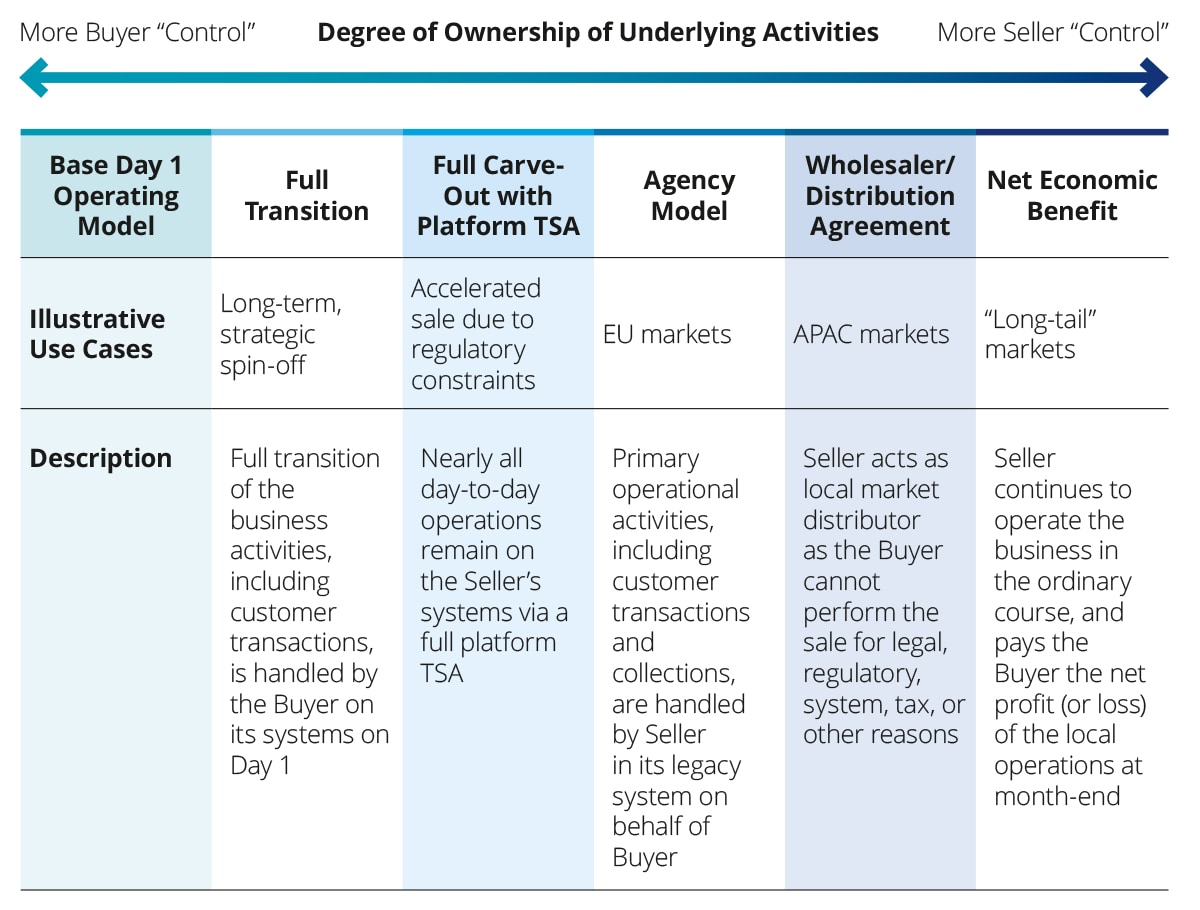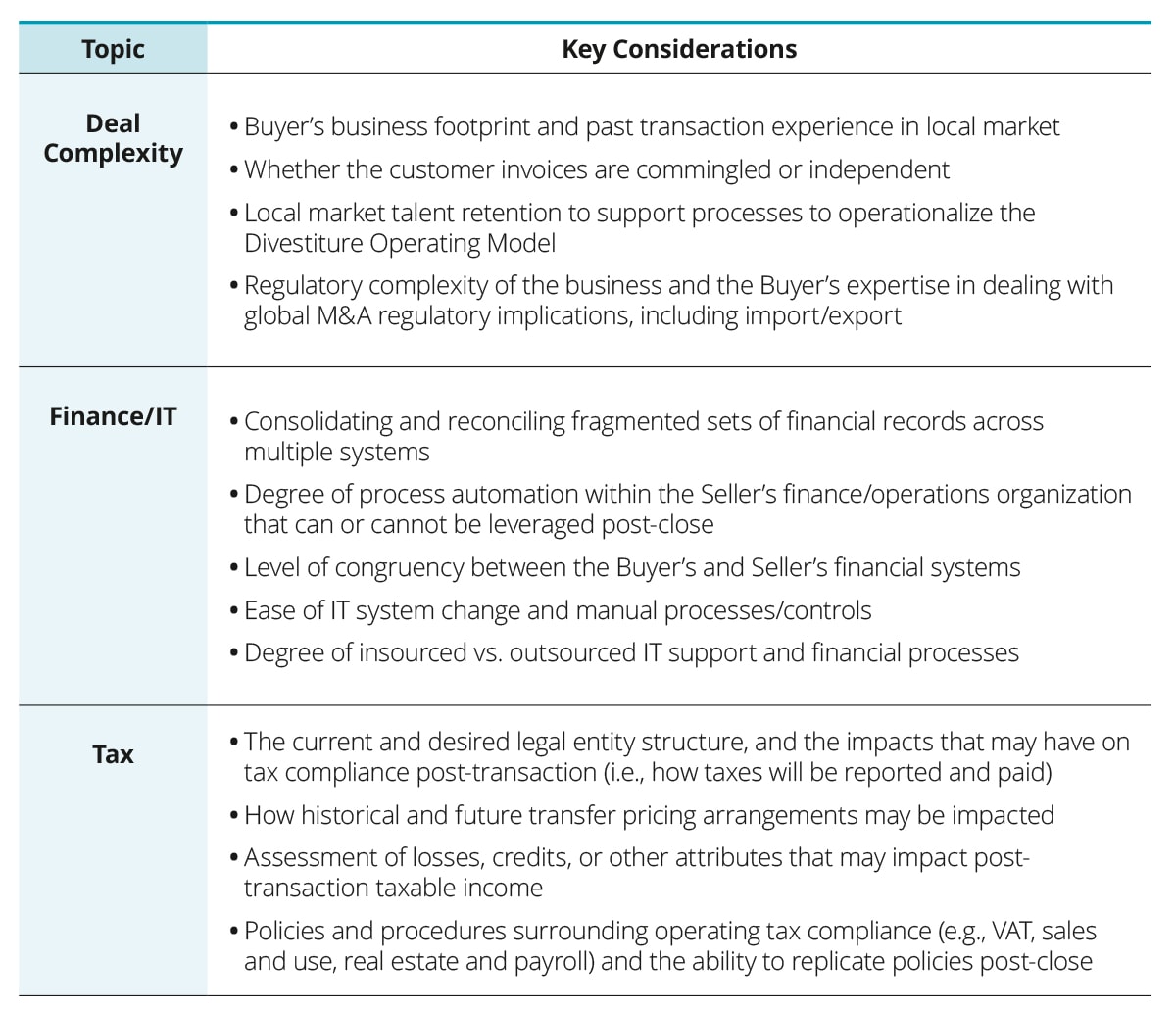Introduction to divestiture strategy and operating models has been saved

Analysis
Introduction to divestiture strategy and operating models
Designing a business divestiture framework
Even with buyers and sellers on the same page, business divestitures can stall unexpectedly, frustrating all parties. Developing an interim operating model as part of the divestiture strategy can help minimize risk and surprise, paving the way for a faster, less disruptive sign-to-close transition.
Introduction to divestiture operating models
The client dilemma
It’s a common scene: A buy-side corporate development officer pauses in frustration during yet another call with the seller. They’re trying to sort out details about a key market that is holding up the business unit divestiture.
“We’re on the same page. As sellers, you want to transfer ownership as soon as possible so you can refocus on your core business. As buyers, we want to implement our strategic plan right after close, but we can’t obtain the marketing authorizations for 12–18 months.”
How do we structure the operations so that we can own and drive the business right after close while the regulatory issues are still being ironed out?
This is a sample dilemma that buyers and sellers often experience while executing a complex global divestiture, and it’s a situation that can be avoided. By starting with a tested and proven base divestiture operating model, buyers and sellers can reduce unnecessary churn on the upfront design phase and accelerate the sign-to-close process by focusing on the most pertinent issues.
The Deloitte approach
For those of you not familiar, divestiture operating models are interim operating constructs that govern the period between transaction close and when the buyer fully takes over the business. During this interim period, the seller provides certain services to the buyer to keep the business running, and the economics are passed to the buyer. These interim divestiture setups come with challenges that most buyers and sellers are not fully equipped to address, such as disentangling a commingled business, establishing an international legal entity structure, assessing tax impacts, reconciling a fragmented set of financial records, and managing system implications on operations and reporting.
Deloitte has helped our clients address these challenges and accelerate transaction close by developing and leveraging the Divestiture Operating Model Toolkit. For instance, Deloitte has found that nearly all variations of divestiture operating models ultimately fall into one of the following five categories:

Using the Toolkit’s base divestiture operating model designs, buyers and sellers can arrive at the appropriate model much sooner and reduce the upfront churn on models that do not address the gating issues or are generally infeasible. The parties can instead focus on tweaking the base model to reflect the unique nuances in the business and local markets, as well as investigating the specific tax and finance implications arising from the divestiture operating model option to help ensure a smooth transition.
Other key considerations when evaluating and choosing the divestiture operating model typically include:

Selection of divestiture operating models is an iterative decision and negotiation process between the buyer and seller during the sign-to-close period. By starting these discussions early, both parties can eliminate unnecessary churn and refocus on the key issues that will help enable a smooth and efficient transition. For more context on divestiture operating models in practice, feel free to reach out to our authors to discuss divestiture operating model options and selection process in more detail.
This publication contains general information only and Deloitte is not, by means of this publication, rendering accounting, business, financial, investment, legal, tax, or other professional advice or services. This publication is not a substitute
for such professional advice or services, nor should it be used as a basis for any decision or action that may affect your business. Before making any decision or taking any action that may affect your business, you should consult a qualified professional advisor.
Deloitte shall not be responsible for any loss sustained by any person who relies on this publication.
Get in touch
 |
Varun Budhiraja Principal, Mergers & Acquisitions Deloitte Consulting LLP |
 |
Louise Chang Principal, Mergers & Acquisitions Deloitte Consulting LLP |
 |
Matt David Senior manager, Transaction Services Deloitte Advisory LLP |
 |
Ryan Stecz Partner, M&A Services Transformation Deloitte Tax LLP |
Recommendations
Divestiture analytics for M&A modeling
Understanding the evolving divestiture market
2024 Global Corporate Divestiture Survey
5 bold steps to becoming ‘divestiture-ready’


